
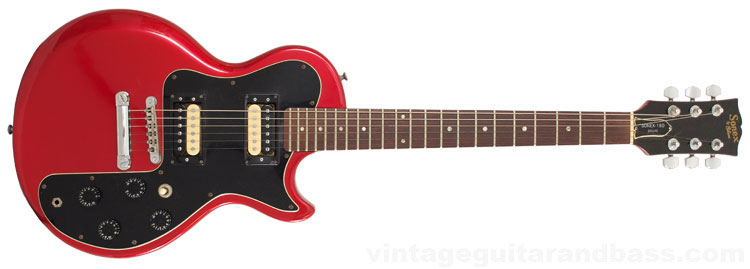 1982 Gibson Sonex 180 Deluxe - have a closer look at this guitar here
1982 Gibson Sonex 180 Deluxe - have a closer look at this guitar here
The entry/mid level solid body guitars being produced by Gibson in the 1970s such as the Melody Maker, Marauder and S-1 were starting to lose their popularity by the late 1970s. Shipping totals for 1979 were barely reaching double figures - not even that in some cases, and by 1980 these models were replaced by two new ranges of affordable guitars, the mid-level Firebrand series guitars, and an innovative new entry level Gibson Sonex series. The Gibson Sonex-180 guitars took the styling of a Les Paul, but married it with innovative new construction that had "brilliant harmonic reproduction and superior sustain" yet was considerably less expensive to produce.
“Gibson Sonex ...capable of creating tonal qualities very similar to those found in our top of the line wood bodied instruments. For example the maple/mahogany combination used in our Les Paul guitars.”
But most importantly to Gibson, as a company, was the fact that these guitars were a separately authorised line; i.e. they could be sold by a whole new network of dealers who did not stock Gibson's higher end products. To this end, they were not branded 'Gibson' but 'Gibson Guitar Company USA' (and briefly 'Sonex by Gibson' in mid 1982). Read more about the Gibson Sonex and Gibson's early eighties product alignment scheme here.
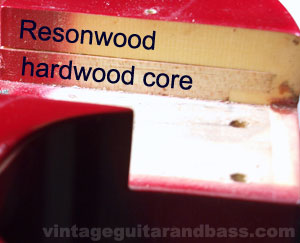
The view inside the neck pocket of a Sonex-180 deluxe. Because this area is traditionally left unpainted, the differences in Resonwood, and the hardwood (maple) core are clearly visible
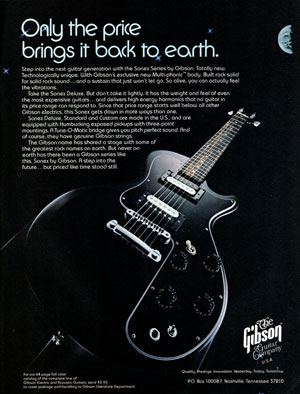
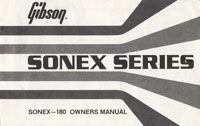
The Sonex Deluxe, Standard and Custom were described in the 1980 Sonex owners manual, giving details of the electronics and their operation, aswell as care of the guitar in general
Like the Marauder and S-1, the Gibson Sonex guitars were constructed with a bolt-on neck, rather than a traditional Gibson set-neck; but rather than a solid wood body, the Sonex series used a Multi-phonic construction, which was both cheap to produce and with highly desirable audio qualities. It comprised an inner solid tone wood core sandwiched between slices of a composite wood material named Resonwood; "a product that will be heralded for years in the future as a first" and one that was "astounding players" with it's "extraordinary sustain and harmonic reproduction" This was not the first time Gibson had used such materials of course, having produced the Kalamazoo range of guitars and basses from a similar pressed wood material 15 years earlier. The image to the right shows the top layer of Resonwood, over the solid maple core.
The "Revolutionary" SONEX series was first demonstrated at the Chicago NAMM fair, June 1980. There were three models available initially, the Sonex-180 Deluxe, Sonex-180 Standard and the Sonex-180 Custom, priced (in 1980) at $299, $375 and $449 respectively; the next cheapest Gibson guitar available in that year was the 335-S standard (solid body version of the famous Gibson ES-335) which was $499. In comparison, the Les Paul Standard was $849 at this time.
All three Gibson Sonex models were listed in the 1980 Gibson catalogue, but by 1981, the Standard had been dropped, being replaced by a short lived and barely known model, the GGC 700. Theoretically this was not a Sonex as it had a mahogany (rather than Resonwood/maple) body with a set neck - but in all other ways it was identical to the Sonex-180 Standard (including headstock branding, pickups and circuitry), and it was placed in the sonex series in the one price list it was included in (January 1982). Another Sonex, first priced in this list, was the Sonex Artist with active electronics, and a set (glued) neck, which was a lot more expensive than the other models at $799 - see the 1981 Gibson Sonex pre-owners 'manual'. It was an extension of the Artist range of guitars with Moog expansion and compression circuitry, first developed for the RD Artist in the mid 1970s.
By the price list of June 1982 the Custom and GGC 700 had been dropped. No Sonex guitars were listed in the 1983 Gibson catalogue, and by 1984 only the Deluxe model was included in price lists, now at $419, in fact the final inclusion of any Sonex model in a US price list.
Electric guitar advertisements originally published from 1981 onwards. Click on the images for larger copies. Check out other vintage Gibson advertisements
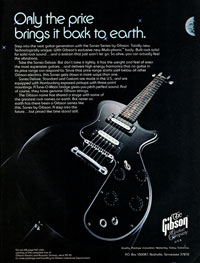
Gibson Sonex-180 deluxe - Only the Price Brings it Back to Earth (1981)
The Sonex series were the most competitively priced guitars in the early eighties Gibson line; styled like a Les Paul, but (at least in the case of the Deluxe) a third of the price. Gibson simply h...
[more]
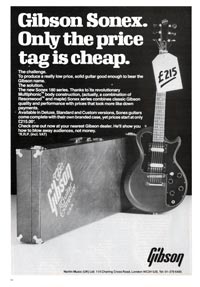
Gibson Sonex-180 deluxe - Gibson Sonex. Only the price is cheap. (1981)
February 1981 British advertisement for the new Sonex series of guitars from Gibson. This ad promotes the whole series, but pictures the entry level model, the Sonex-180 Deluxe. This ad was followe...
[more]
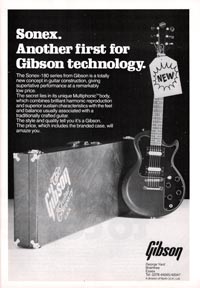
Gibson Sonex-180 deluxe - Sonex. Another first for Gibson technology. (1981)
March 1981 UK advert for the Gibson Sonex series of guitars, following on from a similar advert placed the previous month. The guitar pictured is the Sonex-180 Deluxe, the entry level instrument i...
[more]
The short-lived Gibson Sonex series had little printed publicity. Click the thumbnails for a look through the catalogues in which the Sonex did appear.
A closer look at the differences between the three Sonex-180 guitars and the the Sonex Artist.
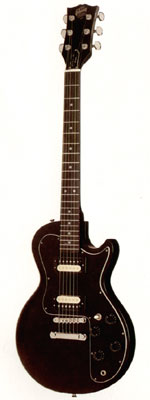
BODY SPECIFICATIONS The new Gibson exclusive Multi-phonic body construction Single cutaway design Adjustable chrome plated Tune-0-Matic bridge with chrome plated stop-bar tailpiece Uniquely shaped double sided fingerrest with white revealed edge Two high output Humbucking 3-point adjustable exposed pickups that feature one black and one cream coil 3-position toggle switch for pickup selection (individual or both pickups simultaneously) Attractive, efficient black speed knobs Body size: Length 17 1/4" width 13" depth 1 3/4"
NECK SPECIFICATIONS One piece select hardwood construction Width at fingerboard nut 1 11/16" Rosewood fingerboard with dot inlays and corresponding side dots Individually enclosed chrome plated machine heads Gibson truss rod with distinctive truss rod cover 22 frets 24 3/4" scale length
SONEX-180 DELUXE Semi gloss Ebony finish (later White, Silver, and several high gloss finishes Candy Apple Red, Silverburst, Antique Fireburst and Electric Blue)
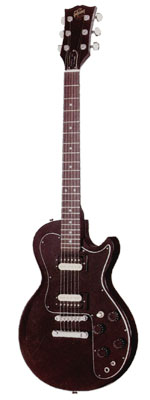
BODY SPECIFICATIONS The new Gibson exclusive Multi-phonic body construction Single cutaway design Adjustable chrome plated Tune-0-Matic bridge with chrome plated stop-bar tailpiece Uniquely shaped double sided fingerrest with white revealed edge Two high output Gibson "Dirty Fingers" 3-point adjustable exposed pickups that feature one cream and one black coil 3-position toggle switch for pickup selection (individual or both pickups simultaneously) Coil tap switch to place either humbucking pickup into a single point non-humbucking mode Attractive, efficient black speed knobs Body size: Length 17 1/4" width 13" depth 1 3/4"
NECK SPECIFICATIONS One piece select hardwood construction Width at fingerboard nut 1 11/16" Rosewood fingerboard with dot inlays and corresponding side dots Individually enclosed chrome plated machine heads Gibson truss rod with distinctive truss rod cover 22 frets 24 3/4" scale length
SONEX-180 STANDARD Ebony finish
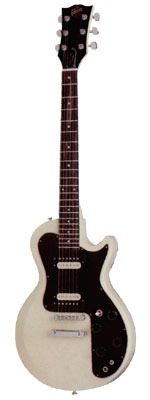
BODY SPECIFICATIONS The new Gibson exclusive Multi-phonic body construction Single cutaway design Adjustable chrome plated Tune-0-Matic bridge with chrome plated stop-bar tailpiece Uniquely shaped double sided fingerrest with white revealed edge Two high output Gibson "Dirty Fingers" 3-point adjustable exposed pickups that feature one cream and one black coil 3-position toggle switch for pickup selection (individual or both pickups simultaneously) Coil tap switch to place either humbucking pickup into a single point non-humbucking mode Attractive, efficient black speed knobs Body size: Length 17 1/4", width 13", depth 1 3/4"
NECK SPECIFICATIONS 3-piece solid maple construction Width at finger board nut 1 11/16" Ebony fingerboard with dot inlays and corresponding side dots Individually enclosed chrome plated machine heads Gibson truss rod with distinctive truss rod cover 22 frets 24 3/4" scale length
SONEX-180 CUSTOM Ebony or White finish (later Candy Apple Red)
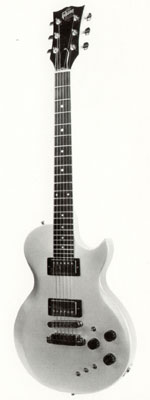
BODY SPECIFICATIONS Exclusive Gibson multiphonic body construction Single Venetian cutaway Chrome-plated new design 3 point adjustable Tune-0-Matic bridge Chrome-plated TP-6 fine tuning stop-bar tailpiece Black fingerrest with black/white revealed edge Active electronics featuring compression expansion, and bright mode circuitry and two compatible humbucking pickups 3-position toggle switch for selecting either pickup individually or both simultaneously Master volume control Full function cut/boost individual bass and treble controls Three mode switches controlling On/Off function of compression, expansion, and bright modes Black speed knobs Chrome-plated "Posi-Lok" strap buttons Body size: Length 17 3/8" width 12 3/4" depth 1 3/4"
NECK SPECIFICATIONS Fixed heel, 3-piece laminated maple construction Width at fingerboard nut 1 11/16" Rosewood fingerboard with pearl dot inlays Deluxe chrome-plated machine heads Gibson truss rod with inscribed "ARTIST" truss rod cover 22 frets 24 3/4" scale length
SONEX ARTIST Candy Apple Red, Silverburst or Ivory finish
The following text is taken from Gibsons 1980 'Sonex by Gibson' leaflet entitled 'Only the price brings it back to earth'
Gibson-Sonex-180 is a totally new kind of guitar. The secret is in the exclusive, new Multi-phonic body design, featuring an incredibly durable and acoustical material called Resonwood. Resonwood has the weight of mahogany and the density of maple. That means you get brilliant harmonic reproduction and superior sustain never before available on on electric guitar at this low price.
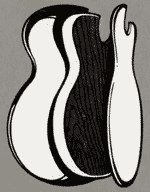
The Sonex Multi-phonic body is composed of Resonwood surrounding an inner tone wood core. The tone wood core not only acts as the anchor point for the neck, it also adds acoustic resonance and exceptional body resilience. The Sonex body is so resilient, that it's structural properties survived extreme testing in temperatures ranging from 40° below to 180°F.
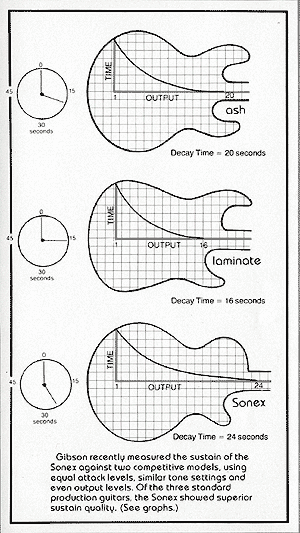
The rock solid consistency of Resonwood gives the Sonex guitar incredible sustain capability. Gibson compared it to conventional ash/poplar laminate models and found there was no comparison. A Sonex Multi-phonic body delivered greater sustain than many guitars priced two and three times higher. And the Sonex-180 has the weight and feel of even the most expensive guitars. Pick it up. Play it.
Experience a Sonex instrument. It's unlike any guitar you've ever played.
There are three guitar models to choose from in the Sonex Series, all with the popular Gibson single cutaway design. The Sonex-180 Deluxe features a rosewood, dot inlayed fingerboard and adjustable exposed coil high output Humbuckers. Other Sonex-180 features include a three-position pick-up selector switch, Tune-0-Matic Bridge', stop bar tailpiece and volume/tone control speed knobs.
In addition to all the features offered on the Deluxe guitar, the Sonex Standard and Custom models feature famous Gibson 'Dirty Fingers' pickups, plus a coil top switch for even more versatility. And to really enhance your playability, the Custom has a three-piece maple neck and ebony fingerboard. The Sonex-180 Custom is also available in a striking white finish, as well as ebony.
Unlike comparably priced guitars, the Gibson Sonex series is made in the U.S., and is backed by a one year, limited warranty on all parts and labor. What's more, Sonex is backed by the strongest service center network in the industry.
Gibson guitars have shared the stage with some of the greatest rock names on earth. But never on earth has there been a Gibson guitar like the Sonex series. Designed for the future. But priced like time stood still.
$900
$1699
$750
$1000
$1550
$1500
$1299
$899
£812
£823